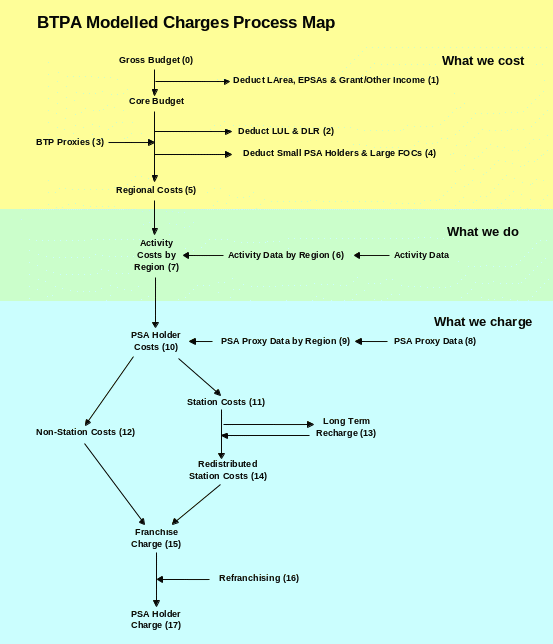BTPA MODELLED CHARGES PROCESS MAP NOTES THIS DOCUMENT
BTPA MODELLED CHARGES PROCESS MAP NOTES THIS DOCUMENTTheorienundModellederDidaktik
BTPA Modelled Charges

BTPA Modelled Charges Process Map - Notes
This document is to be used with reference to the BTPA Modelled Charges Process Map on the previous page. Additionally, these notes also apply to the detailed charges spreadsheet sent in support of PSA holder charges.
Overview
The Matrix Model for calculating PSA Holder charges was introduced for 2007/08 and re-run in 2010/11, 2011/12 and 2012/13. Although the model calculates charges for most PSA holders only eight were applied, the others being charged under the old PA model until 2013 as per the Judicial Review. From 2013/14 onwards, all the model charges will be applied.
The methodology employed can be described by the stages detailed below.
Methodology
Gross Budget (0)
The BTP/BTPA budget is set by the Members in March each year and contains both area and national components. This specifies the budget required to provide all policing services to PSA Holders. This figure includes both the London Area budget and Enhanced PSA costs.
Deduct LArea, EPSA & Grant/Other Income (1)
The London Area budget, Enhanced PSA and Grant/Other Income is deducted from the Gross Budget as these are funded directly by TfL, relevant PSA Holders and funding bodies respectively.
The core budget is broken down further into national and area budgets.
Centrally held funds are attributed to national budget and/or area budgets accordingly by the BTP Finance department.
Deduct LUL & DLR Contribution (2)
The London Underground Limited (LUL) and the Docklands Light Railway (DLR) share some specific services with rest of the BTP. A contribution to these costs is deducted from the national budget components appropriately by the BTP Finance department.
BTP Proxies (3)
The LUL/DLR adjusted national budget components need to be eventually attributed to PSA Holders. As a first step, each budget component is shared across the areas in proportion to the allocated BTP proxy (e.g. the distribution of numbers of staff or numbers of officers across the areas).
Deduct Small PSA Holders & Large FOCs (4)
There are a number of PSA Holders whose charges are calculated outside of the model. These are the Small PSA Holders and the Large Freight Operating Companies (FOCs). The Large FOCs are charged on the basis of their proportion of crimes only.
These charges are deducted from the area level budgets; either from a particular area budget if localised such as a metro system, or proportionately from all budgets if non-localised.
Area Costs (5)
The steps so far translate the Total Cost into six area costs that are to be charged to the remaining larger PSA Holders.
Activity Data by Area (6)
The Activity logs from the BTP can be analysed to give this breakdown by area of frontline Officer activities. A four month representative sample (Feb, May, Aug, Nov-the full year is computationally expensive) is taken and the non-officers excluded. The sixty or so Activity Codes recorded by officers are reduced to 15 Activity Categories by a simple mapping. Of these Categories only 9 can be described as frontline and are processed further, the others such as training and control room duties are discarded. As each officer can generally be associated with an area, so the presented Activity by Area data can be readily derived.
Activity Costs by Area (7)
The outstanding area costs can be split by the relative Activity levels in each area to give Activity Costs by Area. This essentially answers the “What do we do?” question for the PSA Holders. So far all these calculations are BTP oriented and are common to all the larger PSA Holders.
PSA Proxy Data (8)
The rest of this document and spreadsheet refers to a single PSA Holder but applies in a similar manner to all larger PSA Holders.
Each of the Activity by Area costs needs to be recovered from the larger PSA Holders. This is done by using PSA Holder proxy data to represent the PSA Holders share of each cost it incurs.
PSA Proxy Data by Area (9)
Most of the Proxies are at a national level and are converted to a area level by apportioning them in proportion to the PINS data, which is naturally area based.
The PINS data itself is derived from the BTP Crime Recording Database (CRD) which subject to Home Office standards. Each incident recorded is assigned to a PSA Holder initially within the CRD along with location and type information.
Unassigned incidents and those that need to be reassigned (due to refranchising) are processed within the PINS database associated with the model. This database contains a representation of all stations and depots with their manager and users specified.
The incidents are also classified by type; namely Train, Station/Depot or Trackside (used later for the Presence on Network Proxy).
PSA Holder Costs (10)
Multiplying the elements of Activity Costs by Area, by the PSA Holders Proxy Data by Area all the elements of PSA Holders charges (and so ultimately their Total Charge) can be calculated. Activities are subcategorised into Station oriented and Train oriented types. Station costs are processed further by the Long Term Charge mechanism.
Station Costs (11)
Five of the Activities are Station oriented and three of these are apportioned by PINS data which distinguishes Station and Train crimes. Therefore, only the Station (& depot) fraction of crimes of those activity costs are counted towards the overall Station activity costs calculation at this point.
Non-Station Cost (12)
The other five Activities are non-station oriented and are not processed further.
Long Term Recharge (13)
Each PSA holder incurs a charge from Network Rail (NR) for each of the stations it manages called the Long Term Charge (LTC). Each PSA holder offsets its LTC, where possible, by recharging other PSA Holders which uses its stations. This is the Long Term Recharge (LTR) mechanism. This data is collected directly from the PSA Holders.
In a similar manner, a PSA Holders calculated Station Costs are redistributed amongst other PSA Holders in direct proportion to Long Term Charge and Recharge proportions.
The most enlightening example of this is Cross Country. They do not manage any stations so do not directly incur any station costs. Though the LTR mechanism they indirectly accumulate stations costs, which is strongly argued to be appropriate.
Redistributed Station Costs (14)
After the LTR mechanism has been applied the result is the effective Station costs attributable to a PSA Holder, which will vary from the initial calculation.
Franchise Charge (15)
This is the simple sum of the Non-Station Costs and Redistributed Station Cost incurred by the PSA Holder as shown.
Refanchising (16)
Usually a refranchising takes place during the charging year. Each franchise ‘regime’ is calculated similarly to the calculation described here but run in parallel.
The proxies, station ownership & usage data, etc is appropriately altered to model the refranchised regime, and an alternative set of charges calculated.
PSA Holder Charge (17)
The franchise regimes are finally combined by a weighted sum reflecting the number of days each regime applies. This gives the PSA Holder charge for the full year.
Tags: charges process, of charges, charges, notes, document, process, modelled
- PHYSICS 1 – CONCAVE LENSES AND MIRRORS CONCAVE LENSES
- SOLUCIONARIO A LAS PRUEBAS DE ACCESO A LA UNIVERSIDAD
- PHỤ LỤC 3A BCKHXHNV THÔNG TƯ SỐ
- “SEÑORA CÓNSUL SÍRVASE EXTENDER EN EL REGISTRO DE ESCRITURAS
- Inicial Instructivo Calibración Cronómetros Digitales Código Lm01tfi01 Revisión Versión
- CURRICULUM VITAE EUROPASS INFORMAŢII PERSONALE NUME PRENUME NICOLAE
- MEJORAMIENTO ESCUELA PRIMARIA ALDEA LOMAS SAN JACINTO CHIQUIMULA ESPECIFICACIONES
- REDNI BROJ ZAHTJEV ZA IZDAVANJEM JAMSTVA PROGRAM JAMSTVENOG
- PUBLIC INTEREST MAP (PIM) FOR QUEENSLAND GOVERNMENT BODIES FIGURE
- XV JORNADES DE CONSUM CRÍTIC SOBIRANIA ALIMENTARIA I PROCESSOS
- MISSOURI DEPARTMENT OF HEALTH AND SENIOR SERVICES ADVANCED
- MODELO DE COMUNICACIÓN AL PROTECTORADO DE LA CONSTITUCIÓN DE
- AGENDA CONSULTATION ON THE IMPACT OF FREE TRADE AND
- CHART 26 A WHERE AN INDIVIDUAL DISPOSES OF
- PORTAMATRICULAS ADAPTABLE A DUCATI MONSTER 696 08’09’ LICENSE SUPPORT
- II MENYAJIKAN DATA A PENGERTIAN MENYAJIKAN DATA MERUPAKAN TAHAP
- JAARGANG 31 NUMMER 7 OKTOBER 2011 PROTESTANTSE GEMEENTE SCHIERMONNIKOOG
- E SCUELA DE VOLUNTARIADO DE LA COMUNIDAD DE MADRID
- DANA JAMSTVA I IZDACI PO JAMSTVIMA U 2012 GODINI
- BIOMES OF THE WORLD POWERPOINT PROJECT STUDENT HANDOUT
- HRVATSKI ZAVOD ZA ZAPOŠLJAVANJE SREDIŠNJI URED ZAGREB 29052020
- YATIRIM TEŞVİK BELGESİ NEDİR ? YATIRIM TEŞVIK BELGESI TASARRUFLARI
- SUPPLEMENT TO THE ORGANIZATIONAL REVIEW 20042005 187 MEMBERS HAVE
- 5 CHAN 10833 – BRAHMS BRAHMS WORKS FOR SOLO
- BUZ MAKİNASI (KALE) KULLANIM TALİMATI FENEDEBİYAT FAKÜLTESİ KİMYA BÖLÜMÜ
- CIRCULAR OCEBA Nº 10 ELIMINACION DE LA CUOTA CAPITAL
- JANUARY 4 2003 THE MANAGEMENT OF ANEMIA IN PEDIATRIC
- GLUCOSE CONTROL IN THE HOSPITALIZED PATIENT EMERG MED 36(9)1218
- TEBLİĞ AMAÇ VE KAPSAM MADDE 1 – (1) BU
- EUROPASS ŽIVOTOPIS OSOBNÉ ÚDAJE PRIEZVISKO(Á) MENO(Á) OLEŠOVÁ
 W EEKPROGRAM JULIE 20 VRYDAG KOOR KONSERT TE
W EEKPROGRAM JULIE 20 VRYDAG KOOR KONSERT TECHAPTER 2 WHAT SHOULD I KNOW? WHAT DO I
INEQUALITY DISCUSSION CARDS USE OF FOOD BANKS BY LOCAL
 DECRETO Nº 13616 DE 12 DE DEZEMBRO DE 2014
DECRETO Nº 13616 DE 12 DE DEZEMBRO DE 2014DIPHTHERIA CONTACT INVESTIGATION WORKSHEET CLOSE CONTACT HOUSEHOLD MEMBERS
“READING STRATEGIES” 1 MATCHES 1 TO 1 A CHILD
 SEGUIMIENTO Y VIGILANCIA AMBIENTAL SECCIÓN SANIDAD AMBIENTAL ALCIIH PLIEGO
SEGUIMIENTO Y VIGILANCIA AMBIENTAL SECCIÓN SANIDAD AMBIENTAL ALCIIH PLIEGOSOL·LICITUD D’INFORME CEIC (A EMPLENAR PER LA SECRETARIA DEL
 TRABAJO PRACTICO DE INFORMÁTICA 1NOMBRE DEL PERIFÉRICO Y CLASIFICACIÓN
TRABAJO PRACTICO DE INFORMÁTICA 1NOMBRE DEL PERIFÉRICO Y CLASIFICACIÓNCORPORATE AUTHORIZATION RESOLUTION IF THE PROFESSIONAL CONSULTANT IS A
 BLOG DEL VIAJE POR SEGOVIA Y SU PROVINCIA (UN
BLOG DEL VIAJE POR SEGOVIA Y SU PROVINCIA (UNHANDICAPPING GUIDELINES CONTENTS PAGE INTRODUCTION 2 HOW ARE HANDICAPS
 ZAŁĄCZNIK NR 2A DO OGŁOSZENIA KARTA OCENY MERYTORYCZNEJ SZCZEGÓŁOWEJ
ZAŁĄCZNIK NR 2A DO OGŁOSZENIA KARTA OCENY MERYTORYCZNEJ SZCZEGÓŁOWEJ NOTICE OF ANNUAL GENERAL MEETING NOTICE IS HEREBY GIVEN
NOTICE OF ANNUAL GENERAL MEETING NOTICE IS HEREBY GIVEN DOCUMENTO DE PRESENTACIÓN DE OFERTA CONTRATACIÓN UBICACIÓN MUNICIPIO DE
DOCUMENTO DE PRESENTACIÓN DE OFERTA CONTRATACIÓN UBICACIÓN MUNICIPIO DEERŐSÁRAMÚ BERENDEZÉSEK TŰZVÉDELMI FELÜLVIZSGÁLATÁHOZ DOKUMENTÁCIÓ MINTA MEGJEGYZÉS FIGYELEM! A
CDL SCIENZE DELL’AMMINISTRAZIONE SOCIOLOGIA GENERALE SCHEDE DI LAVORO RELATIVE
36 GOBIERNO DE PUERTO RICO 18VA ASAMBLEA 1RA SESIÓN
LA FABRICACIÓN DEL CONSENTIMIENTO LIBROS DE TEXTO Y
EKSAMEN MASTER I RETTSSOSIOLOGI OG KRIMINOLOGI VÅR 2006